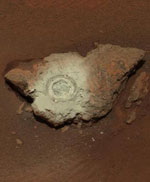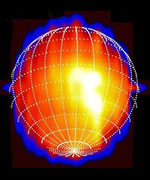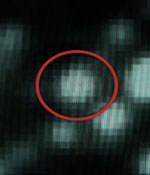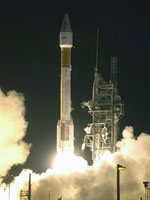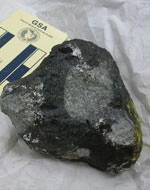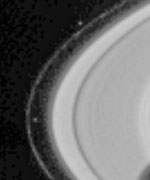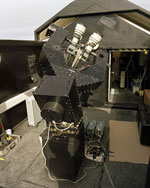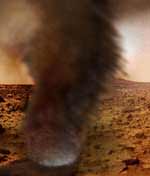
Image credit: NASA
Scientists have found clues that dust devils on Mars might have high-voltage electric fields, based on observations of their terrestrial counterpart. This research supports NASA’s Vision for Space Exploration by helping to understand what challenges the Martian environment presents to explorers, both robotic and eventually human.
NASA and university researchers discovered that dust devils on Earth have unexpectedly large electric fields, in excess of 4,000 volts per meter (yard), and can generate magnetic fields as well. Like detectives chasing down a suspect, the scientists attached instruments to a truck and raced across deserts in Nevada (2000) and Arizona (2001), driving through dust devils to get their measurements as part of the Martian Atmosphere and Dust in the Optical and Radio (MATADOR) activity. The Arizona observations also included a fixed base camp with a full suite of meteorological instruments (refer to Item 2 for a picture of the Arizona campaign).
Dust devils are like miniature tornadoes, about 10 to 100 meters wide with 20- to 60-mile-per-hour (32- to 96-km/hr) winds swirling around a hot column of rising air. “Dust devils are common on Mars, and NASA is interested in them as well as other phenomena as a possible nuisance or hazard to future human explorers,” said Dr. William Farrell of NASA’s Goddard Space Flight Center in Greenbelt, Md. “If Martian dust devils are highly electrified, as our research suggests, they might give rise to increased discharging or arcing in the low-pressure Martian atmosphere, increased dust adhesion to space suits and equipment, and interference with radio communications.” NASA’s Mars Testbed missions in the coming decade may be able to investigate whether such is the case. Farrell is lead author of a paper on this research published in the Journal of Geophysical Research April 20.
“Complex tracks, generated by the large Martian dust devils, are commonly found in many regions of Mars, and several dust devils have been photographed in the act of scouring the surface,” said MATADOR Principal Investigator Dr. Peter Smith of the University of Arizona (Tucson). “These Martian dust devils dwarf the 5- to 10-meter terrestrial ones and can be greater than 500 meters in diameter and several thousand meters high. The track patterns are known to change from season to season, so these huge dust pipes must be a large factor in transporting dust and could be responsible for eroding landforms.”
“Two ingredients, present on both Earth and Mars, are necessary for a dust devil to form: rising air and a source of rotation,” said Dr. Nilton Renno of the University of Michigan, a member of the research team who is an expert in the fluid dynamics of dust devils. “Wind shear, such as a change in wind direction and speed with altitude, is the source for rotation. Stronger updrafts have the potential to produce stronger dust devils, and larger wind shear produces larger dust devils.”
Dust particles become electrified in dust devils when they rub against each other as they are carried by the winds, transferring positive and negative electric charge in the same way you build up static electricity if you shuffle across a carpet. Scientists thought there would not be a high-voltage, large-scale electric field in dust devils because negatively charged particles would be evenly mixed with positively charged particles, so the overall electric charge in the dust devil would be in balance.
However, the team’s observations indicate that smaller particles become negatively charged, while larger particles become positively charged. Dust devil winds carry the small, negatively charged particles high into the air, while the heavier, positively charged particles remain near the base of the dust devil. This separation of charges produces the large-scale electric field, like the positive and negative terminals on a battery. Since the electrified particles are in motion, and a magnetic field is just the result of moving electric charges, the dust devil generates a magnetic field also.
If Martian dust grains have a variety of sizes and compositions, dust devils on Mars should become electrified in the same way as their particles rub against each other, according to the team (refer to Item 1 for an artist’s concept of an electrified Martian dust devil). We experience more static electricity on dry days because water molecules draw charge from electrified objects. Since the Martian atmosphere is extremely dry, the charging is expected to be strong, as there will be few atmospheric water molecules to steal charge from the dust grains. However, since the density of the Martian atmosphere is much lower than Earth’s, the near-surface electrical conductivity of the Martian atmosphere is expected to be 100 times higher. A Martian dust devil will therefore take longer to fully charge, since the increased atmospheric conductivity draws charge away from Martian dust grains.
To date, none of the robotic Mars landers and rovers that have operated on the Martian surface have experienced any consequences of this phenomena, including the rovers Spirit and Opportunity. However, more complex landed laboratories, such as the Mars Science Laboratory (MSL), slated to launch in 2009, may be far more sensitive to electrical disturbances than previous missions. As such, this research is a key stepping stone to more advanced robotic and human exploration of Mars.
Martian dust storms, which can cover the entire planet, are also expected to be strong generators of electric fields (Item 3 shows dust suspended in the Martian atmosphere as a result of Martian dust devil and dust storm activity). The team hopes to measure a large dust storm on Earth and have instruments to detect atmospheric electric and magnetic fields on future Mars landers.
The team includes researchers from NASA Goddard, NASA Glenn (Cleveland, Ohio), NASA Jet Propulsion Laboratory (Pasadena, Calif.), University of Arizona (Tucson), University of California (Berkeley), SETI Institute (Mountain View, Calif.), University of Washington (Seattle), University of Michigan (Ann Arbor), and Duke University (Durham, N.C.). This research was sponsored in part by the NASA Mars Fundamental Research Program, which is operated out of NASA Headquarters in Washington, DC.
Original Source: NASA News Release

